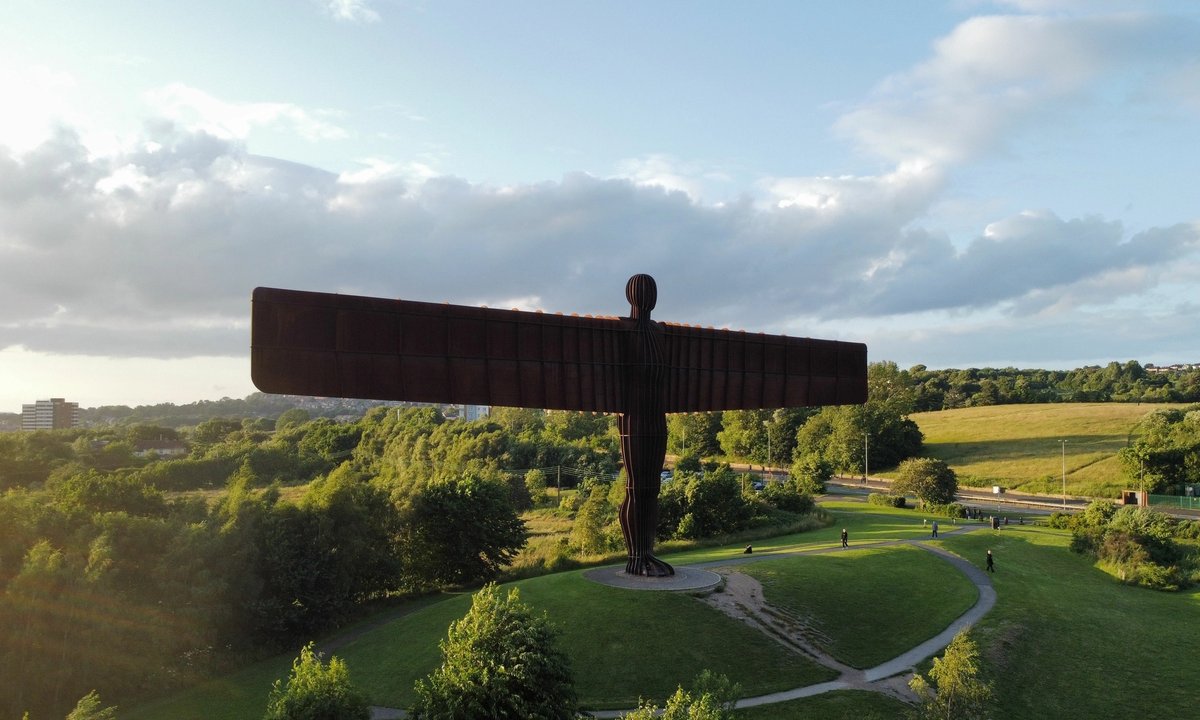One of many projects funded by the National Lottery was Antony Gorley’s famed Angel of the North, erected in Gateshead in 1998, which received £584,000
Wirestock/Adobe Stock
Thirty years ago today, millions across the UK huddled around their televisions, all hoping—and secretly expecting—to win a bundle of cash in the first-ever National Lottery draw. The jackpot at the time was £5.9m.
Crucially, the Conservative then prime minister John Major pledged that ticket sales, at a cost of £1 each, would help to fund the arts, sports, charities, national heritage and millennium celebrations. It was hoped that this would provide a lifeline for the beleaguered culture sector.
In a statement released today, the National Lottery says: “Thanks to National Lottery players, more than £30m is raised every week for Good Causes, funding over 700,000 projects across community, heritage, sport and the arts in Great Britain and Northern Ireland.”
The range of beneficiaries is striking. In 2004, £990,000 was awarded for an investigation to “locate and characterise” the 1485 Bosworth battlefield where King Richard III was killed. And in 2019, £72,200 was given to a project documenting the contribution of the Windrush Generation to Welsh society. Meanwhile cultural landmarks funded by the National Lottery include Antony Gorley’s famed Angel of the North, erected in Gateshead in 1998, which received £584,000.
In its recent report Britain’s oldest political think tank, the Fabian Society, praised the scheme. “Without the profound impact of National Lottery funding for the arts, heritage, charity and tourism sectors, introduced by the Conservative government in 1994, survival of even the fittest would have been nigh on impossible,” says the society's Arts and Creative Industries Unit in Arts for Us All.
Indeed the lottery has bankrolled many major UK capital museum projects. At the turn of the century the National Lottery Heritage Fund gave London’’s Victoria and Albert Museum a grant of £15m for its British Galleries project. Later, in 2012, Tate received £4.9m for the Tate Britain Millbank project, which involved upgrading a number of Tate Britain’s galleries.
Meanwhile, to mark the fund’s 30th birthday, 15 heritage projects have this year received grants from a pot of more than £30m. Tilbury Riverside Station in Essex received £4.5m to create a community hub, including artists’ studios and a cafe, in a former station building at the port where the Empire Windrush docked in 1948.
But the Fabian Society wants an overhaul. “A lottery review would look at the National Lottery Distribution Fund and identify how it can best address the crisis in arts and heritage capital and infrastructure funding across the country, as well as ensure the future sustainability, including energy efficiency, of some of our greatest cultural buildings,” a statement says.
Currently the National Lottery funding is allocated by the National Lottery Distribution Fund (NLDF), which splits the lottery pie in four ways. First, 20% goes to the arts, which is distributed across Arts Council England, Creative Scotland, Arts Council of Wales, Arts Council of Northern Ireland and the British Film Institute. Next 20% goes to sport, providing funding in particular for TeamGB and the Paralympics GB Olympics squads, and 20% to heritage causes, which is distributed via the National Lottery Heritage Fund, covering museums and galleries. Finally, 40% is distributed via the National Lottery Community Fund to charitable causes, health, education and the environment.
The Fabian Society, however, suggests that one key change could be to temporarily increase the level of funding allocated to arts and heritage by 5%, taking it from 20% to 25%. This 5%, the society says, would be deducted from the 40% currently earmarked for the Community Fund, as a time-limited switch.
Others too have concerns. In 2018, the arts consultant James Doeser wrote: “Since its introduction in the mid-1990s, the UK National Lottery has made a lot of poor people slightly poorer while equipping Arts Councils to enrich an arts sector that disproportionately serves the better-off… the National Lottery is gambling, but I would wager that it does not feel that way to most people. Instead, it is seen as a benign form of play, a modest voluntary tax on the innumerate and deluded.”
In its November 2022 report, the UK Culture, Media and Sport parliamentary committee, which feeds into government policy, noted that draw-based lottery games generally posed “little harm” to the public, although the harm was “not zero”. Sasha Stark, former senior researcher at the Responsible Gambling Council, told the committee that lottery play was “not a benign form of gambling”.
Successive governments have meanwhile said that Lottery funding does not act as a replacement for government funds—a regulation known as the “additionality principle”. This point was reiterated earlier this year in a parliamentary briefing paper which marked the appointment of Allwyn, a conglomerate owned by the Czech billionaire Karel Komárek, as the new lottery operator. “There has always been a demarcation between lottery funding and government spending but this should always be closely monitored,” said an anonymous UK fundraising consultant.
Maurice Davies, senior associate at Cultural Associates Oxford—a management consultancy focusing on the cultural creative industries— acknowledges that there will always be debates about the best ways to raise funds for public spending. However, he describes the lottery overall as having been “quite progressive”.
“It has insisted heritage and cultural organisations engage with a wide range of types of people and get closer to their communities, especially the heritage lottery, which has probably done more than anything else to make UK museums outward looking,” he explains. “There are fundamental structural weaknesses in UK cultural and heritage, especially in museum and gallery funding, around long-term sustainable funding and geographic inequality with for example massive over provision in central London, but overall the lottery has been an enormous force for good.”

